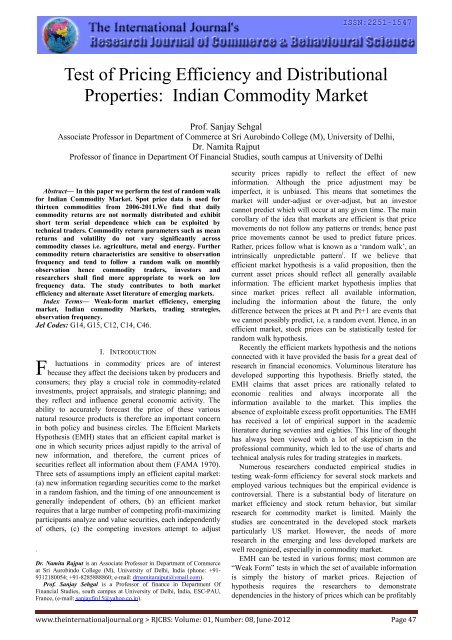Research Journal of Commerce & Behavioural Science - RJCBS
Research Journal of Commerce & Behavioural Science - RJCBS
Research Journal of Commerce & Behavioural Science - RJCBS
Create successful ePaper yourself
Turn your PDF publications into a flip-book with our unique Google optimized e-Paper software.
Test <strong>of</strong> Pricing Efficiency and Distributional<br />
Properties: Indian Commodity Market<br />
Pr<strong>of</strong>. Sanjay Sehgal<br />
Associate Pr<strong>of</strong>essor in Department <strong>of</strong> <strong>Commerce</strong> at Sri Aurobindo College (M), University <strong>of</strong> Delhi,<br />
Dr. Namita Rajput<br />
Pr<strong>of</strong>essor <strong>of</strong> finance in Department Of Financial Studies, south campus at University <strong>of</strong> Delhi<br />
<br />
Abstract— In this paper we perform the test <strong>of</strong> random walk<br />
for Indian Commodity Market. Spot price data is used for<br />
thirteen commodities from 2006-2011.We find that daily<br />
commodity returns are not normally distributed and exhibit<br />
short term serial dependence which can be exploited by<br />
technical traders. Commodity return parameters such as mean<br />
returns and volatility do not vary significantly across<br />
commodity classes i.e. agriculture, metal and energy. Further<br />
commodity return characteristics are sensitive to observation<br />
frequency and tend to follow a random walk on monthly<br />
observation hence commodity traders, investors and<br />
researchers shall find more appropriate to work on low<br />
frequency data. The study contributes to both market<br />
efficiency and alternate Asset literature <strong>of</strong> emerging markets.<br />
Index Terms— Weak-form market efficiency, emerging<br />
market, Indian commodity Markets, trading strategies,<br />
observation frequency.<br />
Jel Codes: G14, G15, C12, C14, C46.<br />
F<br />
I. INTRODUCTION<br />
luctuations in commodity prices are <strong>of</strong> interest<br />
because they affect the decisions taken by producers and<br />
consumers; they play a crucial role in commodity-related<br />
investments, project appraisals, and strategic planning; and<br />
they reflect and influence general economic activity. The<br />
ability to accurately forecast the price <strong>of</strong> these various<br />
natural resource products is therefore an important concern<br />
in both policy and business circles. The Efficient Markets<br />
Hypothesis (EMH) states that an efficient capital market is<br />
one in which security prices adjust rapidly to the arrival <strong>of</strong><br />
new information, and therefore, the current prices <strong>of</strong><br />
securities reflect all information about them (FAMA 1970).<br />
Three sets <strong>of</strong> assumptions imply an efficient capital market:<br />
(a) new information regarding securities come to the market<br />
in a random fashion, and the timing <strong>of</strong> one announcement is<br />
generally independent <strong>of</strong> others, (b) an efficient market<br />
requires that a large number <strong>of</strong> competing pr<strong>of</strong>it-maximizing<br />
participants analyze and value securities, each independently<br />
<strong>of</strong> others, (c) the competing investors attempt to adjust<br />
.<br />
Dr. Namita Rajput is an Associate Pr<strong>of</strong>essor in Department <strong>of</strong> <strong>Commerce</strong><br />
at Sri Aurobindo College (M), University <strong>of</strong> Delhi, India (phone: +91-<br />
9312180054; +91-8285888860; e-mail: drnamitarajput@ymail.com).<br />
Pr<strong>of</strong>. Sanjay Sehgal is a Pr<strong>of</strong>essor <strong>of</strong> finance in Department Of<br />
Financial Studies, south campus at University <strong>of</strong> Delhi, India, ESC-PAU,<br />
France, (e-mail: sanjayfin15@yahoo.co.in).<br />
security prices rapidly to reflect the effect <strong>of</strong> new<br />
information. Although the price adjustment may be<br />
imperfect, it is unbiased. This means that sometimes the<br />
market will under-adjust or over-adjust, but an investor<br />
cannot predict which will occur at any given time. The main<br />
corollary <strong>of</strong> the idea that markets are efficient is that price<br />
movements do not follow any patterns or trends; hence past<br />
price movements cannot be used to predict future prices.<br />
Rather, prices follow what is known as a ‘random walk’, an<br />
intrinsically unpredictable pattern i . If we believe that<br />
efficient market hypothesis is a valid proposition, then the<br />
current asset prices should reflect all generally available<br />
information. The efficient market hypothesis implies that<br />
since market prices reflect all available information,<br />
including the information about the future, the only<br />
difference between the prices at Pt and Pt+1 are events that<br />
we cannot possibly predict, i.e. a random event. Hence, in an<br />
efficient market, stock prices can be statistically tested for<br />
random walk hypothesis.<br />
Recently the efficient markets hypothesis and the notions<br />
connected with it have provided the basis for a great deal <strong>of</strong><br />
research in financial economics. Voluminous literature has<br />
developed supporting this hypothesis. Briefly stated, the<br />
EMH claims that asset prices are rationally related to<br />
economic realities and always incorporate all the<br />
information available to the market. This implies the<br />
absence <strong>of</strong> exploitable excess pr<strong>of</strong>it opportunities. The EMH<br />
has received a lot <strong>of</strong> empirical support in the academic<br />
literature during seventies and eighties. This line <strong>of</strong> thought<br />
has always been viewed with a lot <strong>of</strong> skepticism in the<br />
pr<strong>of</strong>essional community, which led to the use <strong>of</strong> charts and<br />
technical analysis rules for trading strategies in markets.<br />
Numerous researchers conducted empirical studies in<br />
testing weak-form efficiency for several stock markets and<br />
employed various techniques but the empirical evidence is<br />
controversial. There is a substantial body <strong>of</strong> literature on<br />
market efficiency and stock return behavior, but similar<br />
research for commodity market is limited. Mainly the<br />
studies are concentrated in the developed stock markets<br />
particularly US market. However, the needs <strong>of</strong> more<br />
research in the emerging and less developed markets are<br />
well recognized, especially in commodity market.<br />
EMH can be tested in various forms; most common are<br />
“Weak Form” tests in which the set <strong>of</strong> available information<br />
is simply the history <strong>of</strong> market prices. Rejection <strong>of</strong><br />
hypothesis requires the researchers to demonstrate<br />
dependencies in the history <strong>of</strong> prices which can be pr<strong>of</strong>itably<br />
www.theinternationaljournal.org > <strong>RJCBS</strong>: Volume: 01, Number: 08, June-2012 Page 47
















